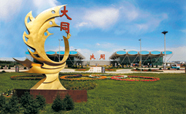Chinese "Coal Capital" Gets Ancient Face-lift
Datong resident Zhang Haitao said he used to live in a city marked by shoddy apartment blocks and bad roads before the local government kicked off an ambitious city planning project in 2008.
Once the capital of the Northern Wei Dynasty (386-534), Datong, located in the northern province of Shanxi, is home to the magnificent Yungang Grottoes -- a UNESCO World Heritage Site featuring over 52,000 pieces of stone Buddhist scriptures, the Hanging Monastery, which was built into a cliff 60 meters above the ground some 1,500 years ago, as well as other ancient treasures.
But instead of being recognized as an ancient city full of treasures and relics, Datong has been dubbed the country's "coal capital" for its rich coal reserves reaching 71.8 billion tonnes.
The city paid too much attention to the coal resources and neglected city planning work as well as all those precious antiquities, which made it dreary over the past few decades, said Zhang.
"Urban construction is stagnant in Datong. It feels like the city has lost 20 years," Zhang said.
Things started to change in 2008 when a new mayor, Geng Yaobo, took office, and later made his name by rejuvenating the city and preserving cultural sites.
Preserving the old town is at the core of Geng's plan. Datong is divided into two parts by the Yuhe River, and the city will preserve the western part as the old town for its ancient cultural sites while the region to the river's east is set for modernization.
All modern buildings from the 3.28-square-km old town, which is surrounded by old city walls, are being removed from the district. The city is repaving most streets and restoring the old town to how it would have been during the Ming Dynasty (1368-1644).
Scores of palaces and temples are being built with bricks and wooden beams as copies of their archetypes, transforming the city beyond recognition for modern onlookers.
The Huayan Monastery, once reduced to just two halls by ancient wars, has been renovated to appear as it did in the Tang Dynasty (618-907).
Meanwhile, workers are restoring the ancient city walls by covering the ruins -- sections of soil mounds -- with bricks.
The last time the government repaired the city walls was in 1372 when the walls dating back to the Liao Dynasty (907-1125) were expanded to the present scale.
The large project has inevitably triggered controversy. In 2009 alone, the city demolished buildings with a combined floor area of 820,000 square meters, nearly twice the size of Vatican City.
Most residents currently living in the old town will have to move to a new district outside the city walls where new residential buildings will be provided.
"Nobody wants to move, but pieces of cultural heritage are vanishing at a speed that barely leaves us any time to wait," Geng said. "We have to take action."
The projects are expected to cost a hefty 50 billion yuan (about 7.4 billion U.S. dollars), prompting public doubt over whether the huge investment will be paid off by what Geng gambles will be the city's future economic pillar -- the tourism industry.
The money comes from government funds, bank loans, private investments and the local government's land trading profits, according to Geng.
Geng is confident in the city's future as a tourist destination.
Entrance tickets at heritage sites alone will bring the city 300 million yuan annually after construction is finished in the old town in three years, he said.
Bullet trains connecting Beijing and Datong will begin operating by the end of this year, slashing travel time to just one hour from the current five to six hours, Geng said, adding that he expects 3 million tourists to arrive in Datong annually in just a few years.
Copyright 1995 - 2010 . All rights reserved. The content (including but not limited to text, photo, multimedia information, etc) published in this site belongs to China Daily Information Co (CDIC). Without written authorization from CDIC, such content shall not be republished or used in any form. Note: Browsers with 1024*768 or higher resolution are suggested for this site.

